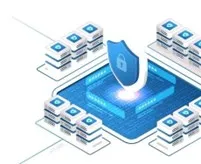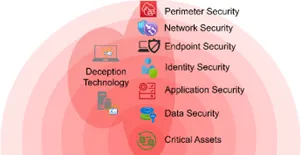Deception Technology
Deception Technology: An Advanced Cyber-Defence Strategy
What is Deception Technology?
Deception Technology is an advanced form of cyber defence, where cyber deceptions that mimic real network assets are overlayed across the enterprise network and are used to lure and detect attackers. Since legitimate users have no reason to interact with a deception, any interaction with a deception generates a high-fidelity alert.
Core Components of Deception Technology
-
Decoys:
Decoys are realistic replicas of production systems, applications, services, or devices designed to attract attackers. These can include fake servers, databases, endpoints, IoT devices, or cloud resources. Decoys are configured to look and behave like legitimate assets but serve no real business function—any interaction with them is a strong signal of malicious activity.
-
Lures and Breadcrumbs:
Lures are small, deceptive data elements—such as fake credentials, configuration files, or document links—planted in strategic locations like endpoints, cloud storage, or Active Directory. They guide attackers toward decoys by mimicking authentic access points or sensitive information, effectively steering adversaries away from real assets.
-
Telemetry and Threat Intelligence Collection:
Deception environments are designed to gather detailed telemetry when an attacker engages with a decoy. This includes session data, tools used, commands issued, lateral movement patterns, and more. The collected intelligence enhances understanding of attacker tactics and supports incident response, threat hunting, and threat intelligence feeds.
-
Automation and Orchestration:
Modern deception platforms use automation to deploy and manage decoys at scale, adapt to changes in the environment, and reduce manual overhead. Orchestration features allow for integration with broader security operations—triggering containment actions, enriching alerts, and supporting automated responses when threats are detected.
-
Stealth and Realism:
An essential component of effective deception is believability. Deceptive assets must be indistinguishable from legitimate systems. This includes matching hostnames, network behavior, user activity, and system configurations to ensure that even skilled attackers cannot easily detect the ruse.
Together, these components create a dynamic and proactive defense layer that enhances threat detection, disrupts attacker progress, and strengthens the overall security posture.
How Threat Deception Technology Works
Threat deception technology works by creating a carefully crafted web of decoy assets within an organization’s infrastructure to lure, detect, and analyze malicious behavior. It begins with the deployment of deceptive elements across the network. These deceptive artifacts are designed to appear authentic to attackers while serving no operational purpose. Any interaction with them is inherently suspicious and triggers an alert.
Once an attacker engages with a deception element by logging in with a deceptive credential, accessing a decoy database, or opening a baited document, the system captures detailed telemetry about the attacker’s actions, tools, and methods. This data is analyzed in real time and fed into security operations platforms, enabling rapid threat detection, forensic analysis, and informed response. Advanced deception platforms also use automation and machine learning to adapt the deception layer dynamically, ensuring it remains realistic and aligned with the organization’s evolving environment. Ultimately, deception technology not only helps detect and isolate threats early but also misleads attackers, slows their progress, and provides actionable intelligence to strengthen future defenses.
Advantages of Deception Technology
Enhanced Threat Detection
Since deception technology does not depend on attack signatures or other static indicators, it can detect a range of threats. For threats such as Ransomware that is the most prevalent attack today and evolves rapidly, cyber deception provides an extremely timely response to detect, arrest and deny access, with minimal or no manual intervention.
Significant Reduction in False Positives
Deception technology employs deceptive assets which are not real network assets or resources. If someone engages with a deceptive asset, it can’t be for legitimate business purposes and is therefore likely an intruder. Using deception techniques gives high-fidelity detections and defense teams are not spending time working through false positives.
Coordinated Defense Response
Advanced cyber deception technology solutions like ShadowPlex integrate with a wide range of solutions such as SOAR, SIEM, EDR, AD, and Network Management Solutions, among others. They leverage integrations with these defense systems for network discovery, gathering forensic data from endpoints, breadcrumb and bait deployment on network endpoints and assets, as well as for automated response.
Threat Intelligence
Solutions that employ deception techniques to detect attacks also gather intelligence about attack TTPs (Tactics, Techniques, and Procedures) based on actual observed behavior, which can be used for forensics or threat hunting.
Easy Scalability
With deception technology, the number of decoys and their distribution across the enterprise can be easily scaled. Fluid Deception and the sharing of compute resources allows organizations to minimize the amount of compute, storage, and software licenses required.
Deception Technology vs. Traditional Honeypots
Deception technology has evolved significantly beyond the capabilities of traditional honeypots, offering a broader, more dynamic approach to threat detection and response. Traditional honeypots are static decoy systems designed to mimic vulnerable assets, primarily useful for studying attacker behavior in controlled environments. However, they often require substantial setup and maintenance, and savvy attackers may recognize and avoid them. In contrast, modern deception technology deploys a wide range of lightweight, context-aware decoys—such as honeytokens, fake credentials, and decoy services, across an organization’s entire infrastructure. These tools are distributed, harder to detect, and tightly integrated with real production environments, enabling faster detection of threats, lateral movement, and insider activity without requiring attackers to fully engage a dedicated honeypot system.
Limitations of Legacy Detection Tools
Legacy detection tools, such as signature-based antivirus and traditional intrusion detection systems (IDS), struggle to keep pace with modern, sophisticated threats. These tools often rely on known attack patterns and predefined rules, making them ineffective against zero-day exploits, fileless malware, and insider threats. They also generate high volumes of false positives, leading to alert fatigue and missed threats. Furthermore, legacy systems tend to focus on perimeter security, assuming clear boundaries between trusted and untrusted networks, an assumption that no longer holds in today’s cloud-driven, hybrid environments. As attackers adopt more stealthy and adaptive tactics, organizations must move beyond reactive, rule-based detection and embrace proactive, deception-based strategies that detect threats based on behavior rather than known signatures.
What are the types of cyber deceptions used?
Cyber deceptions could be in the form of decoys that are added to the network. Decoys could mimic endpoints or servers running different operating systems, routers or switches, databases, web servers, OT assets such as PLCs, and a whole range of other network assets.
Other forms of deception techniques include Breadcrumbs that are deployed on existing enterprise assets, Baits that act as tripwires on endpoints and Lures that are deliberately mis-configured or vulnerable services or applications that can be effectively used in uncovering latent threats.

A special class of deceptions that has proved very effective at detecting identity threats are Honey Accounts and Honeytokens.
Dynamic Deception: Why It Matters
Dynamic deception is a modern, adaptive approach to cybersecurity that continuously evolves to mirror the complexity and fluidity of real-world environments. Unlike static decoys or fixed honeytokens, dynamic deception technologies generate and update deceptive assets, such as credentials, files, systems, and services in real time, tailoring them to match the live environment. This realism makes it significantly harder for attackers to distinguish decoys from legitimate resources, increasing the likelihood of engagement and detection. Dynamic deception also allows organizations to respond to changes in network topology, user behavior, and threat intelligence, ensuring that deceptive elements remain relevant and effective. By creating an ever-changing landscape of traps and lures, dynamic deception not only improves detection accuracy and response speed but also increases attacker uncertainty and operational risk, effectively turning the tables in favor of the defender.
How is Deception Technology different from other cybersecurity measures?
Deception Technology is a new layer in the cyber defense strategy. Traditional security layers are passive and only look for attacker behaviour, activity, IoCs (Indicators of Compromise), or side effects. Deception technology actively changes the landscape to detect or respond to threats.

How does Deception Technology bring the advantage back to the defenders?
In cybersecurity, over the years, the relationship between the role of the attacker and the role of the defender has become highly asymmetric. Defenders must defend against all possible entry points that can be breached. They must learn to deal with living off-the-land tools and techniques. And the ever-growing list of easily available penetration testing tools. While the attacker has to exploit just one vulnerability or steal one VPN credential to get through these layers of security. This asymmetry highly favours the attacker.
With deception technology solutions like Acalvio ShadowPlex, anything can become a deceptive artifact. Using ShadowPlex, defenders can now embed deceptions everywhere, surround key assets with deceptions, intercept attackers in real-time, and proactively reduce the attack surface attack paths.
With Acalvio ShadowPlex deployed, the attacker has to just interact with any one of these deceptive artifacts to get detected. Even if the attacker is aware that there are deceptions deployed on the network, they can’t do much to evade authentic-looking deceptions. The tables are turned, and the attacker will be detected through these deception techniques sooner or later and contained quickly.
Can Deception Technology Effectively Counter All Types of Adversaries?
Unlike traditional security layers, deception technology is not dependent on the attacker tools, malware programming language, location of access, or the status of endpoint (managed or unmanaged). So, unlike traditional security layers, deception technology can detect both known and unknown threats, including zero day with speed and precision.
Deception Technology Detections
Deception technology can rapidly detect, engage and respond to cybersecurity attacks across hybrid cloud deployments, protecting both IT and OT networks. Solutions based on deceptive techniques can respond to new and emerging threats, including zero-day attacks.
Some of the cybersecurity attacks that can be detected include:
- Malicious network activities- network intrusion diversion, tunneling for deception traffic, network infrastructure obfuscation
- Ransomware, including ransomware propagation through Active Directory
- Advanced Persistent Threats (APTs)
- Data exfiltration
- AD attacks
- Attacks on Industrial Control Systems
- Compromised endpoints
- Early recon activities
- Ping sweeps
- Deep Recon attempts against certain services like Database Servers
- Scans, including vertical, horizontal, null scans, Xmas scans
- Lateral movement attempts
- Vulnerability exploit attempts
- Insider threats
- Pass-the-Hash attacks
- AS-REP roasting
- Kerberoasting
Is Deception Technology suitable for organizations of various sizes?
Since Deception Technology does not depend on specific installations, signatures, or other indicators of compromise to detect adversary activity, it can be scaled up or down to work with organizations of any size. Deception technology is designed for Enterprise IT, IoT and ICS environments. Customized Deceptions are available for IT & OT Networks and they cover both On-Premises and Cloud workloads, and Remote Users.
The Future of Deception Technology
The future of deception technology is poised to play a central role in proactive cybersecurity, driven by advancements in automation, artificial intelligence, and threat intelligence integration. As attack techniques grow more sophisticated, deception will shift from isolated deployments to fully integrated, adaptive security layers woven throughout networks, endpoints, and cloud environments. AI-powered deception systems will dynamically generate realistic decoys, adjust in real time to evolving threats, and correlate deception events with broader security telemetry to enhance threat hunting and response. Additionally, deception technology will become more personalized, tailoring traps to mimic an organization’s unique infrastructure, user behavior, and data flows, making detection more accurate and attacker evasion increasingly difficult. As regulatory pressures increase and cyber risk becomes a board-level concern, deception technology will evolve from a niche capability to a mainstream component of resilient, intelligence-driven security architectures.
How Acalvio Enhances Cybersecurity with Deception
Acalvio enhances cybersecurity through advanced deception technology that seamlessly integrates with enterprise environments to detect, engage, and analyze malicious activity. Its platform, ShadowPlex, uses AI-driven automation to deploy realistic and context-aware decoys across on-premises, cloud, and hybrid infrastructures. Unlike traditional honeypots, Acalvio’s deception is dynamic and scalable, adapting continuously to changes in the network and attacker behavior. It blends into the existing environment without disruption, making it nearly impossible for attackers to distinguish real assets from decoys. By triggering high-fidelity alerts based on genuine attacker interaction rather than signature-based detection, Acalvio reduces false positives and enables faster, more effective incident response. Additionally, it provides rich telemetry and forensic data to support threat hunting and improve overall cyber resilience, making deception not just a detection tool, but a strategic layer of defense.
Frequently Asked Questions
Deception technology is a proactive cybersecurity approach that uses deception to detect and analyze unauthorized activity. These deceptive elements are designed to appear legitimate to attackers but serve no real business function, so any interaction with them is a strong indicator of malicious intent. The goal is to detect threats early, mislead attackers, and collect valuable intelligence without impacting normal operations.
Modern threat deception works by seamlessly deploying dynamic, realistic decoys throughout an organization’s infrastructure, whether on-premises, in the cloud, or across endpoints. These decoys mimic the look and behavior of real systems and data, luring attackers to interact with them. Once triggered, the deception system generates high-confidence alerts and provides detailed telemetry on attacker behavior, tools, and objectives. This enables rapid detection and response while keeping the attacker occupied and away from real assets.
Deception technology can detect a wide range of threats, including external attacks (such as credential theft, lateral movement, and data exfiltration), insider threats, zero-day exploits, and advanced persistent threats (APTs). Because it relies on behavioral detection rather than known signatures, it is particularly effective against stealthy, unknown, or polymorphic attacks that traditional security tools may miss.

